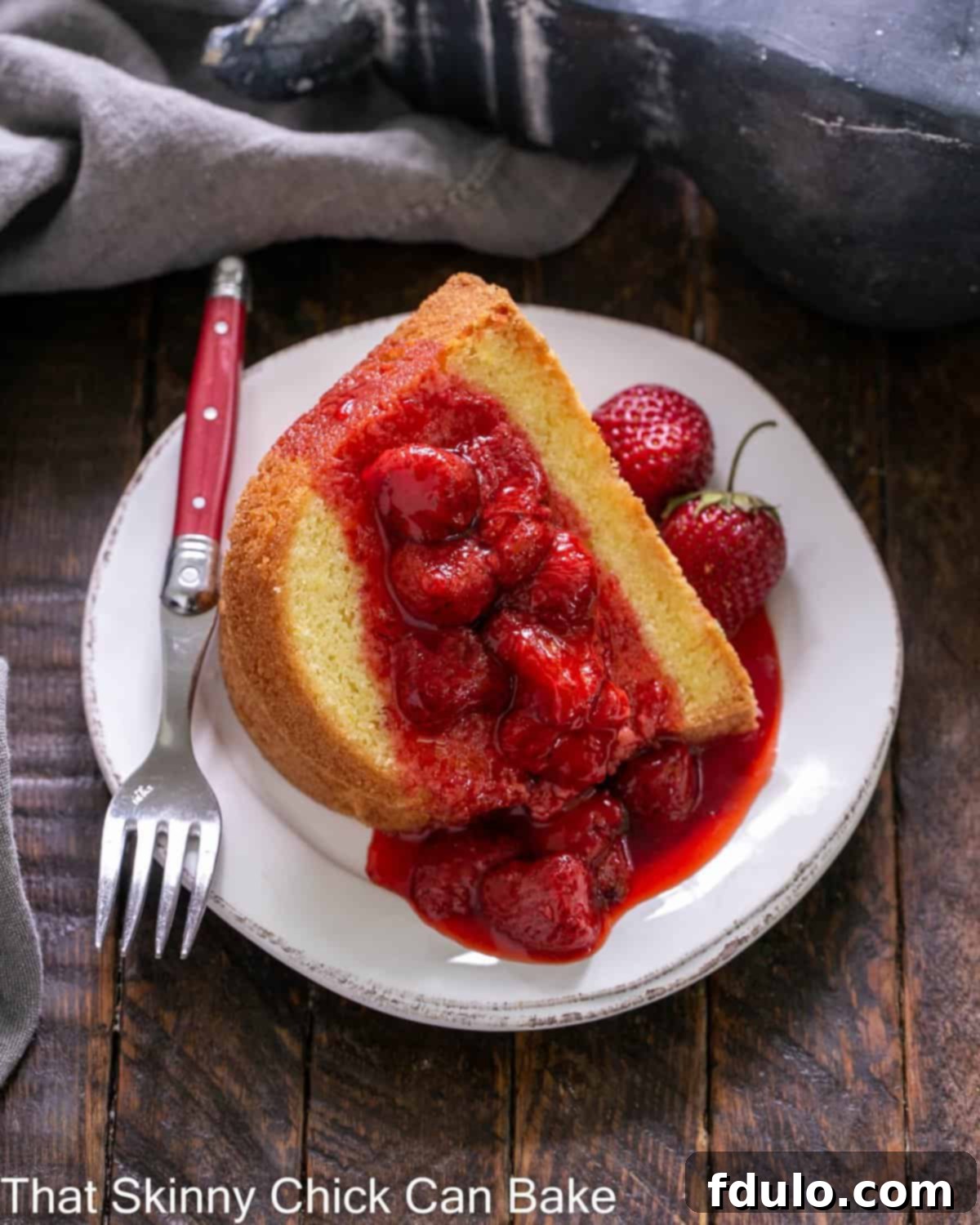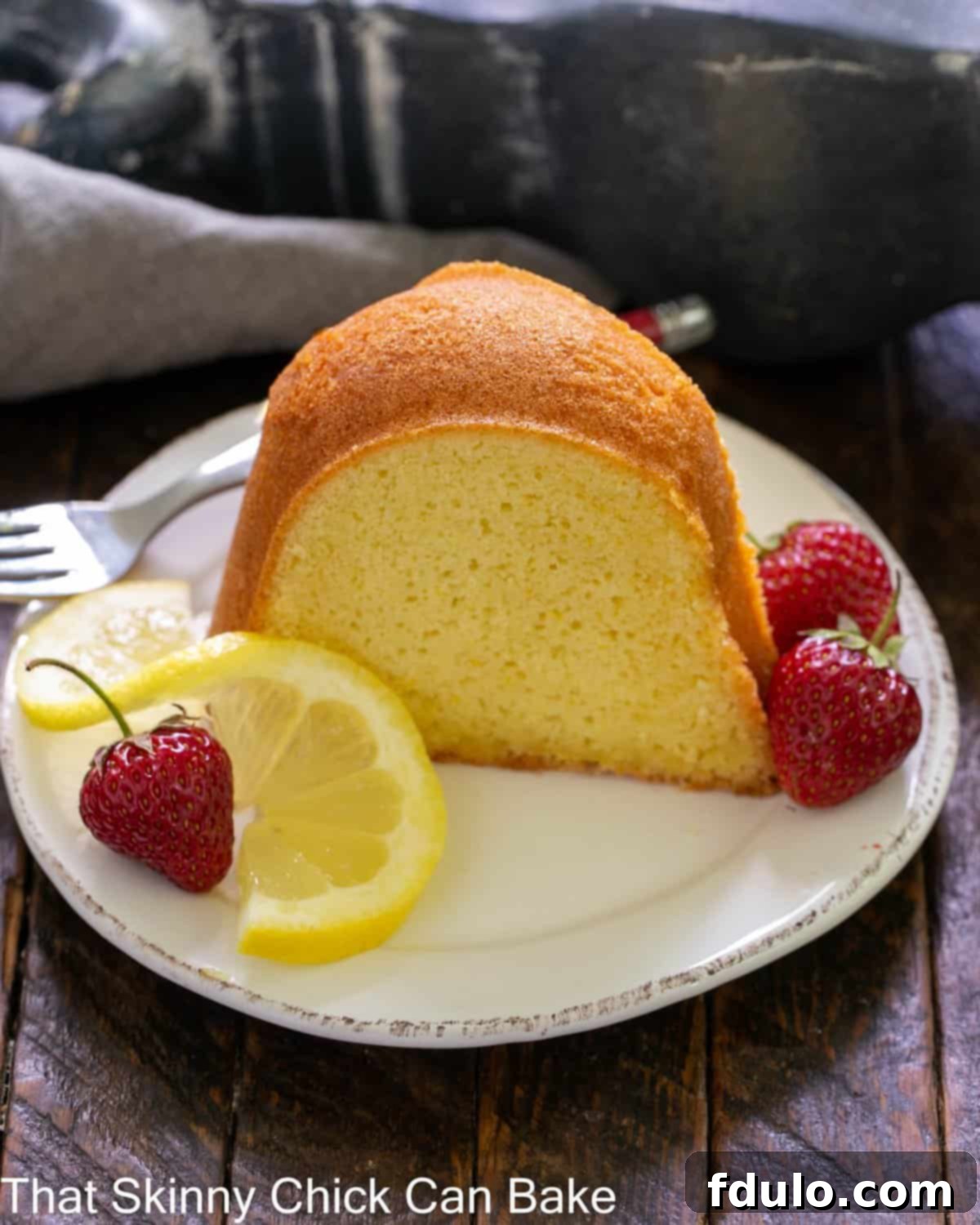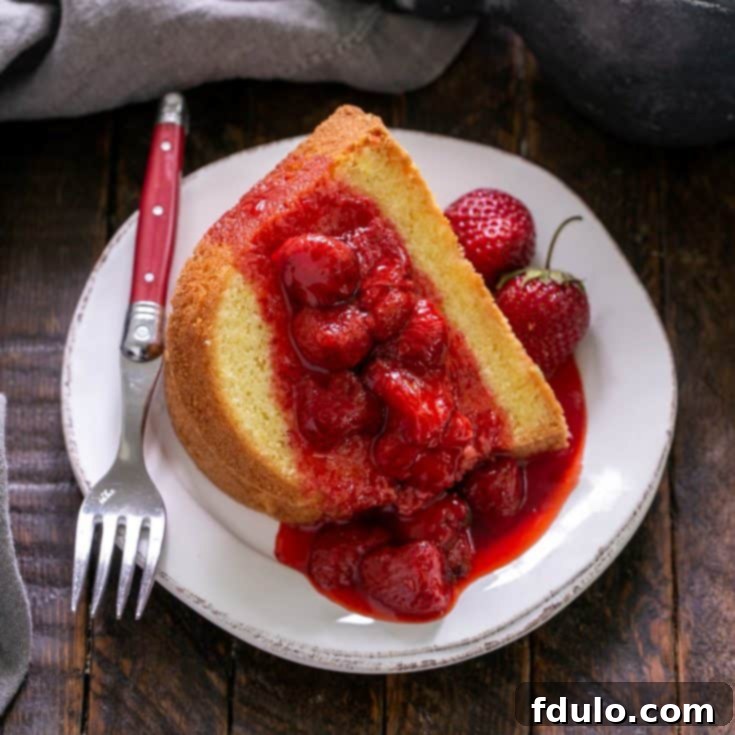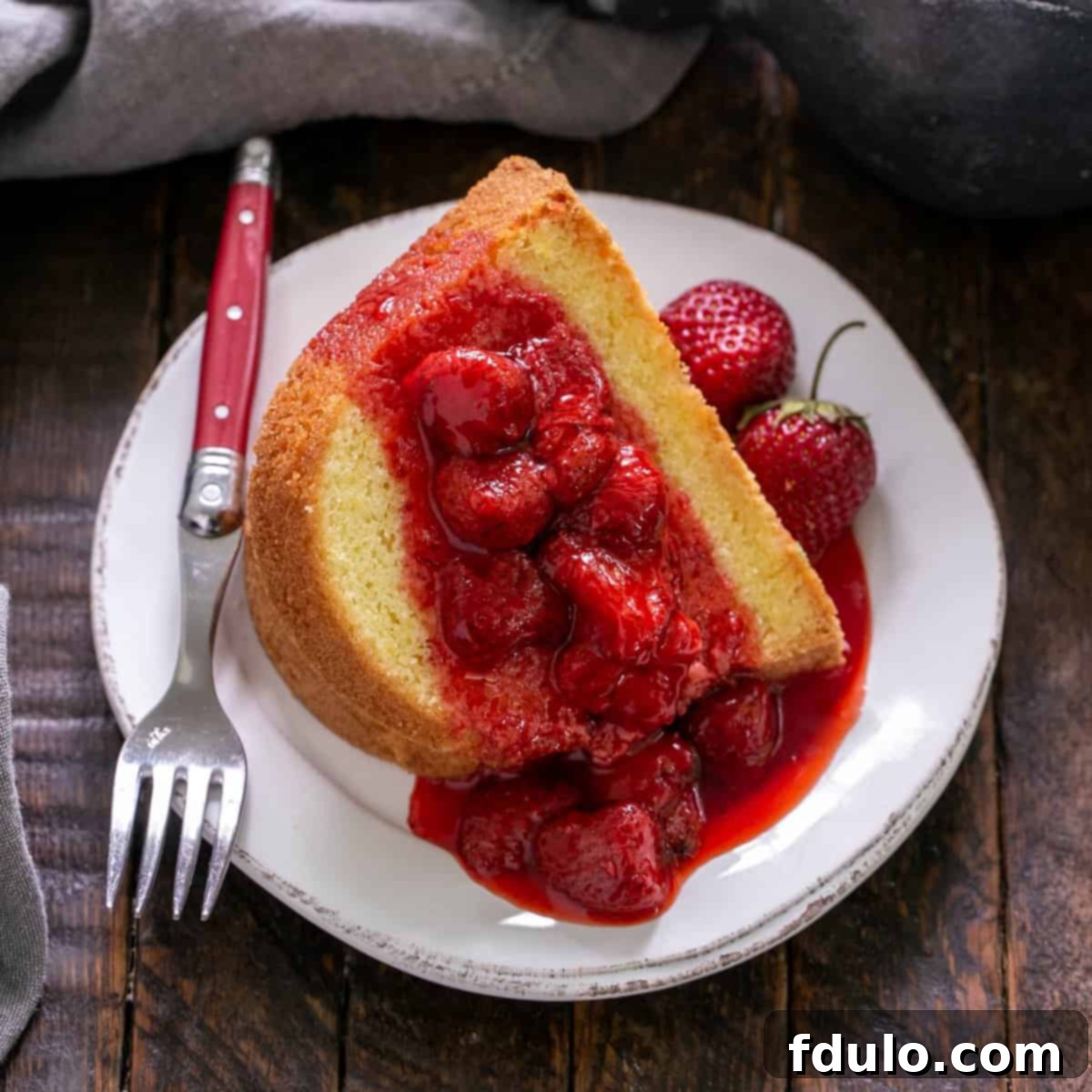Welcome to the ultimate guide for baking an exquisite Lemon Bundt Cake, a dessert that promises to brighten any day with its vibrant citrus aroma and incredibly moist texture. This isn’t just any lemon cake; it’s a celebration of fresh, tangy flavors perfectly balanced with a delightful sweetness. Infused with the invigorating zest and extracts of both lemon and orange, this cake delivers a complex, aromatic burst of flavor that truly stands out. It’s the quintessential centerpiece for any gathering, especially when paired with the bountiful fresh berries of summer.
Imagine a dense, tender slice of this Lemon Pound Cake, elevated by a luscious Fresh Strawberry Compote. The vibrant red of the berries against the pale yellow cake creates a visually stunning dessert that’s as appealing to the eyes as it is to the palate. This pairing makes it an absolute showstopper for summer entertaining, bringing a touch of homemade elegance to your table with minimal fuss.

Why This Lemon Bundt Cake Is a Must-Bake
There are countless reasons to add this sensational Lemon Bundt Cake to your baking repertoire. It’s more than just a dessert; it’s an experience waiting to happen. Here’s why this recipe will become your new favorite:
- Perfect for Any Gathering: This generously sized, moist lemon pound cake is designed to serve 12 or more people, making it an ideal choice for larger family dinners, holiday celebrations, potlucks, or any special occasion where you need to impress a crowd with minimal effort. Its impressive Bundt shape naturally elevates its presentation.
- A Summer Berry Showcase: As summer arrives, so does an abundance of fresh, local berries. This cake provides the perfect, subtly sweet, and tangy base to highlight the natural sweetness and vibrant colors of strawberries, blueberries, raspberries, or blackberries. It’s a delicious way to celebrate seasonal produce.
- A Dream for Lemon Lovers: If you adore the bright, zesty flavor of lemon, this cake is crafted specifically for you. The combination of fresh lemon and orange zest, alongside lemon and orange extracts, creates an unparalleled citrus explosion that is both refreshing and deeply satisfying. It’s truly an indulgence for anyone who craves that distinctive lemon tang.
- Elegant and Effortless: The Bundt pan does most of the decorative work for you, creating a beautiful, fluted cake that requires minimal additional embellishment. A simple dusting of powdered sugar or a drizzle of lemon glaze is often all it needs, making it a surprisingly effortless way to achieve an elegant dessert.
Unveiling the Perfect Lemon Bundt Cake: A Step-by-Step Guide
Creating this magnificent Lemon Bundt Cake is a rewarding process. Follow these detailed steps to ensure a flawless bake and a truly delicious result.
- Preparation is Key: Begin by cutting 1 pound of cold butter into 1-tablespoon pieces and placing them in the bowl of your standing mixer. Allow the butter to sit at room temperature for approximately 30 minutes. This slight softening is crucial for the ideal texture. Simultaneously, whisk together 6 eggs, 3 egg yolks, 1 tablespoon of vanilla extract, 1 teaspoon of orange extract, and 1 teaspoon of lemon extract in a liquid measuring cup. Let this egg mixture also come to room temperature while you prepare the pan.
- Preheat and Prepare Your Pan: Adjust your oven rack to the middle position and preheat the oven to 325°F (160°C). Thoroughly butter a 14-cup capacity Bundt pan, ensuring every crevice is coated. Dust the buttered pan generously with flour, then tap out any excess. Proper pan preparation is vital to prevent sticking.
- Creaming the Butter: Attach the paddle attachment to your stand mixer. Beat the slightly softened butter at medium-high speed for about 15 seconds until it appears shiny, smooth, and creamy. Remember to scrape down the bottom and sides of the bowl once with a rubber spatula to ensure even mixing.
- Adding the Sugar: Reduce the mixer speed to medium. With the mixer running, gradually pour in 3 cups of sugar in a slow, steady stream. This should take about one minute. Once all the sugar is incorporated, increase the speed to medium-high and continue beating the mixture for 5 to 8 minutes. The goal is a light, fluffy, and almost white mixture. Don’t forget to scrape down the bowl once during this process. Finally, mix in ½ teaspoon of table salt, the zest of 2 lemons, and the zest of 1 orange.
- Incorporating the Egg Mixture: With the mixer still running at medium speed, gradually add the room temperature egg mixture in a slow, steady stream. This step should take about 60 to 90 seconds. Once fully incorporated, scrape the bottom and sides of the bowl. Increase the speed to medium-high and beat the mixture until it becomes light and fluffy, approximately 3 to 4 minutes. Remove the bowl from the mixer and give it one final scrape.
- Folding in the Flour: In three separate additions, sift 3 cups of cake flour and 1 teaspoon of baking powder over the butter/egg mixture in the bowl. After each addition, gently fold the flour into the batter using a rubber spatula until just combined. Be careful not to overmix. Scrape along the bottom of the bowl to ensure there are no pockets of unmixed flour.
- Baking to Perfection: Carefully scrape the prepared batter into the greased and floured Bundt pan. Use an offset spatula to smooth the surface of the batter evenly. Bake for approximately 70 to 80 minutes, or until a clean toothpick inserted into the center of the cake comes out free of wet batter.
- Cooling and Serving: Once baked, cool the cake in the pan on a wire rack for 5-10 minutes. This crucial cooling time allows the cake to firm up slightly before you attempt to remove it. After 5-10 minutes, invert the cake onto the wire rack, then gently turn it right side up. Allow the cake to cool completely to room temperature on the rack, which typically takes about 2 hours. Slice and serve this delightful Lemon Bundt Cake with your favorite strawberry compote, a dollop of whipped cream, or a scoop of vanilla ice cream.

Expert Tips for a Flawless Lemon Bundt Cake
Baking a truly exceptional Lemon Bundt Cake involves a few key techniques and insider secrets. Mastering these tips will elevate your cake from good to absolutely unforgettable.
- Embrace Fresh Zest: The quality of your citrus zest makes an enormous difference. Always opt for fresh lemon and orange zest. Jarred alternatives simply cannot replicate the vibrant aroma, essential oils, and textural nuances that fresh zest provides, which are crucial for this cake’s signature flavor.
- Room Temperature Eggs are a Must: For optimal emulsification and a smoother batter, ensure your eggs are at room temperature. This allows them to incorporate more easily and evenly into the butter and sugar mixture, resulting in a more uniform and tender crumb.
- The 60°F Butter Secret: While many recipes call for room temperature butter, this specific recipe thrives with butter that is slightly cooler, around 60°F (15°C). At this temperature, the butter will give slightly to gentle pressure but will still feel firm. This cooler butter helps create the desired dense, yet tender, pound cake texture.
- Choose the Right Attachment: When using a stand mixer, always use the paddle attachment for this recipe. A whisk attachment incorporates too much air into the batter, which can lead to a lighter, less dense cake, straying from the traditional pound cake texture we’re aiming for.
- Creaming Time is Crucial: Do not rush the creaming process. Beat the sugar and butter with the paddle attachment for a full 4-5 minutes, scraping down the bowl once or twice. This lengthy creaming incorporates air and lightens the mixture, preventing the cake from turning out overly dense and heavy. It’s a critical step for the cake’s ultimate texture.
- Gentle Flour Folding: When incorporating the flour, use a rubber spatula and fold it in gently. Mix only until the flour is just combined. Overmixing will develop the gluten in the flour, leading to a tough, chewy, and overly dense cake. The key is a light hand.
- PRO-Tip: Half Batch for a Loaf Pan: Need a smaller cake for a less crowded occasion? You can easily halve this recipe and bake it in a standard 9 x 5-inch loaf pan. The baking time will be roughly the same, but it’s wise to start checking for doneness a bit earlier.
- The Reliable Toothpick Test: The toothpick test remains the gold standard for checking if your cake is fully baked. Insert a clean wooden toothpick into the deepest part of the cake (often the crack that forms across the top). If it comes out clean, without any wet batter clinging to it, your cake is done.
- PRO-Tip: Master Bundt Pan Greasing: Bundt pans are notorious for sticking, especially older or well-used ones. To avoid disappointment, grease your pan exceptionally well. Use solid vegetable shortening (Crisco) or softened butter, ensuring every nook and cranny is coated. Then, dust thoroughly with flour, tapping out any excess. For an extra layer of security, some bakers prefer a baking spray with flour.
- Patient Cooling is Paramount: Allow your cake to cool in the pan on a wire rack for 5 to 10 minutes, but no longer. This brief cooling period allows the cake to set and firm up enough to be safely removed. If you cool it for too long in the pan, it can sweat and potentially stick, making removal difficult.

Frequently Asked Questions About Lemon Bundt Cake
Here are answers to some common questions that arise when baking and serving this delightful Lemon Bundt Cake.
What is the Difference Between a Compote and a Coulis?
A coulis (pronounced koo-LEE) is typically a thick, strained puree or sauce, often made from fruits or vegetables, and is smooth in texture. A compote (pronounced KAHM-poht), on the other hand, is a dish made of fresh or dried fruit cooked slowly in a sugar syrup, retaining distinct pieces of fruit. It’s usually served chilled and has a thicker, more textured consistency.
What Can You Use Instead of a Bundt Pan to Make this Lemon Cake Recipe?
This versatile recipe can be easily adapted. If you don’t have a Bundt pan, or prefer a different shape, you can halve the recipe and bake it in a standard-sized 9 x 5-inch loaf pan. When using a loaf pan, begin checking your cake for doneness after 50-60 minutes, using the toothpick test.
What Goes Well with a Lemon Pound Cake?
Lemon pound cake is wonderfully versatile. A slice is perfectly complemented by any macerated seasonal berries such as strawberries, blueberries, raspberries, or blackberries. For an extra touch of indulgence, a dollop of lightly sweetened whipped cream or a scoop of premium vanilla ice cream would be absolutely delicious. To round out the dessert course, consider serving it with a warm cup of hot tea or freshly brewed coffee.
Why is it Called a Pound Cake?
The name “pound cake” originates from the traditional recipe’s ingredient proportions. Historically, the original pound cake recipe called for a pound each of butter, sugar, flour, and eggs. Over time, variations and additional flavorings were introduced, but the name stuck as a testament to its rich, dense texture and generous quantities of staple ingredients.
How Do You Store Pound Cake?
To keep your pound cake fresh, store it well at room temperature for up to 3 days. Ensure it is wrapped tightly first with plastic wrap, and then with aluminum foil, to prevent it from drying out. Pound cake also freezes exceptionally well for longer storage, up to 3 months. To serve, simply defrost it overnight in the refrigerator, and then allow it to come to room temperature before slicing and enjoying.
Can I use all-purpose flour instead of cake flour?
While cake flour is recommended for its lower protein content, which results in a tenderer crumb, you can substitute all-purpose flour. For every cup of cake flour, use 1 cup of all-purpose flour minus 2 tablespoons, then add 2 tablespoons of cornstarch back in. Sift this mixture together. The cake may be slightly denser, but still delicious.
How do I make a simple lemon glaze for my Bundt cake?
For a quick and easy lemon glaze, whisk together 1½ cups of powdered sugar with 2-3 tablespoons of fresh lemon juice until smooth and pourable. Add more lemon juice for a thinner glaze, or more powdered sugar for a thicker one. Drizzle over the cooled cake.
Delightful Dessert Pairings and Related Recipes
If you’ve fallen in love with this Lemon Bundt Cake, you’re in for a treat! Explore other irresistible pound cake and bundt cake recipes that promise the same level of homemade goodness and deliciousness. These selections are perfect for expanding your baking horizons or finding another favorite to share with loved ones.
- Coconut Cream Cheese Pound Cake from Call Me PMc: A rich and creamy twist on the classic, infused with tropical coconut flavor.
- Raspberry Amaretto Bundt Cake: A sophisticated bundt cake featuring the sweet-tartness of raspberries and the nutty notes of amaretto.
- Sour Cream Pound Cake: Renowned for its incredibly moist and tender crumb, thanks to the addition of sour cream.
- Strawberry Pound Cake: A delightful cake bursting with fresh strawberry flavor, perfect for spring and summer.
- Best Pound Cake: The foundational recipe for a perfectly dense, moist, and classic pound cake.
- Discover all my Best Cake Recipes for more baking inspiration and delicious creations.
- Plus, I’ve just released 3 e-book recipe collections: Cookies, Bar Cookies, and Brownies. They’re perfect for gifts or treating yourself!
Stay connected with us and discover more delicious recipes by following on social media @ Instagram, Facebook, and Pinterest. Don’t forget to tag me when you try one of my recipes – I love seeing your creations! If you’re thrilled with the results, please consider leaving a 5-star rating in the recipe card.

Lemon Bundt Cake with Strawberry Compote
20 minutes
1 hour 20 minutes
1 minute
1 hour 41 minutes
12 servings
A dense, delicious lemon pound cake topped with a sweet, fresh strawberry compote, perfect for any occasion.
Ingredients
For the Lemon Bundt Cake:
- 1 pound cold butter, plus more for greasing the pan
- 3 cups granulated sugar
- 6 large eggs, at room temperature
- 3 large egg yolks, at room temperature
- 1 tablespoon pure vanilla extract
- 1 teaspoon orange extract
- 1 teaspoon lemon extract
- ½ teaspoon table salt
- Zest of 2 fresh lemons
- Zest of 1 fresh orange
- 3 cups cake flour, plus extra for dusting the pan
- 1 teaspoon baking powder
Instructions
- Prepare Ingredients: Cut 1 pound of cold butter into 1-tablespoon pieces and place in the bowl of a standing mixer; let stand at room temperature for about half an hour to soften slightly to 60°F. In a separate liquid measuring cup, whisk together eggs, egg yolks, vanilla extract, orange extract, and lemon extract until combined. Let this egg mixture also stand at room temperature until ready to use.
- Preheat Oven and Pan: Adjust oven rack to the middle position and preheat oven to 325°F (160°C). Thoroughly butter a 14-cup capacity Bundt pan, ensuring all surfaces are covered. Dust the pan with flour, then invert and tap out any excess flour.
- Cream the Butter: Using a stand mixer fitted with the paddle attachment, beat the slightly softened butter at medium-high speed until shiny, smooth, and creamy, about 15 seconds. Scrape the bottom and sides of the bowl once with a rubber spatula.
- Add Sugar and Zest: Reduce speed to medium. With the mixer running, gradually pour in the 3 cups of sugar; this should take about a minute. Once all sugar is added, increase speed to medium-high and beat until the mixture is fluffy and almost white in color, 5 to 8 minutes, scraping the bottom and sides of the bowl once. Mix in the salt and citrus zests until well combined.
- Incorporate Egg Mixture: With the mixer running at medium speed, gradually add the egg mixture in a slow, steady stream. This step should take 60 to 90 seconds to allow for proper emulsification. Scrape the bottom and sides of the bowl, then beat the mixture at medium-high speed until light and fluffy, 3 to 4 minutes. Remove the bowl from the mixer and give it one final scrape.
- Fold in Dry Ingredients: In 3 additions, sift the cake flour and baking powder over the butter/egg mixture. After each addition, gently fold with a rubber spatula until just combined. Be careful not to overmix. Scrape along the bottom of the bowl to ensure the batter is well mixed and no pockets of dry flour remain.
- Bake the Cake: Scrape the batter into the prepared Bundt pan and smooth the surface with an offset spatula. Bake until a toothpick inserted into the center of the cake comes out clean, about 70 to 80 minutes.
- Cool and Serve: Cool the cake in the pan on a wire rack for 5-10 minutes. This brief cooling period helps the cake firm up. Invert the cake onto the wire rack, then turn the cake right side up. Cool completely to room temperature on the rack, about 2 hours, before slicing. Serve with compote, whipped cream, and/or ice cream.
Notes
This recipe has been adapted from Cook’s Illustrated, February 2007, ensuring a consistently delicious result.
Remember, your butter should soften to about 60°F. It will yield to gentle pressure but will still be firm, not greasy.
Find my detailed Strawberry Compote Recipe by clicking the link for the perfect accompaniment.
Recommended Products
As an Amazon Associate and member of other affiliate programs, I earn from qualifying purchases. These are products I personally recommend for baking success:
- KitchenAid KSM150PSER Artisan Tilt-Head Stand Mixer with Pouring Shield, 5-Quart, Empire Red
- Silicone Spatulas (Heat Resistant)
- High-Quality Nonstick Bundt Pan (14-cup capacity)
Nutrition Information:
Yield: 12 servings
Serving Size: 1 slice
Amount Per Serving (estimated):
- Calories: 790 kcal
- Total Fat: 36g
- Saturated Fat: 21g
- Trans Fat: 1g
- Unsaturated Fat: 12g
- Cholesterol: 267mg
- Sodium: 414mg
- Total Carbohydrates: 107g
- Fiber: 2g
- Sugar: 52g
- Protein: 11g
Disclaimer: Thatskinnychickcanbake.com occasionally offers nutritional information for recipes contained on this site. This information is provided as a courtesy and is an estimate only. This information comes from online calculators. Although thatskinnychickcanbake.com attempts to provide accurate nutritional information, these figures are only estimates. Varying factors such as product types or brands purchased can change the nutritional information in any given recipe. Also, many recipes on thatskinnychickcanbake.com recommend toppings, which may or may not be listed as optional and nutritional information for these added toppings is not listed. Other factors may change the nutritional information such as when the salt amount is listed “to taste,” it is not calculated into the recipe as the amount will vary. Also, different online calculators can provide different results. To obtain the most accurate representation of the nutritional information in any given recipe, you should calculate the nutritional information with the actual ingredients used in your recipe. You are solely responsible for ensuring that any nutritional information obtained is accurate.
